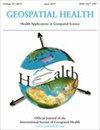印度尼西亚爪哇岛流行区分区一级的聚集性疟疾病例。
IF 1
4区 医学
Q4 HEALTH CARE SCIENCES & SERVICES
引用次数: 6
摘要
疟疾仍然是印度尼西亚重要的公共卫生问题之一。2015年最初被设定为爪哇岛的消灭目标,但爪哇岛仍有几个县报告了疟疾病例。空间技术有助于确定疟疾传播的地方差异,控制风险地区,并评估干预措施的结果。分区一级疟疾分布模式的信息,以空间、时间和时空数据的形式呈现,对规划控制干预措施至关重要。爪哇三个县(Banyumas、Kebumen和Purbalingga)的分区一级疟疾传播信息是从区域发展局(Bapeda)、人口和民事登记局(Disdukcapil)和印度尼西亚统计局(BPS)收集的。ArcGis 10.2和SaTScan 8.0使用地理信息系统(GIS)对全球空间自相关和时空聚类以及纯空间和纯时间分析进行了研究,以检测疟疾高风险地区。我们的研究结果表明,疟疾在爪哇中部的研究区域,特别是在Banyumas和Purbalingga县,在空间上是聚集的。时间分析显示,疟疾集群主要出现在1-4月期间。时空分析结果表明,爪哇中南部有一个最有可能的疟疾集群和三个次级集群。最有可能的集群位于Purbalingga Regency,覆盖一个街道,从2016年初一直持续到2018年底。所采用的方法有助于确定控制和消除疟疾的资源优先事项。本文章由计算机程序翻译,如有差异,请以英文原文为准。
Clusters of malaria cases at sub-district level in endemic area in Java Island, Indonesia.
Malaria remains one of the essential public health problems in Indonesia. The year 2015 was originally set as the elimination target in Java Island, but there are still several regencies on Java reporting malaria cases. Spatial technology helps determine local variations in malaria transmission, control risk areas and assess the outcome of interventions. Information on distribution patterns of malaria at the sub-district level, presented as spatial, temporal, and spatiotemporal data, is vital in planning control interventions. Information on malaria transmission at the sub-district level in three regencies in Java (Banyumas, Kebumen, and Purbalingga) was collected from the Agency for Regional Development (Bappeda), the Population and Civil Registration Agency (Disdukcapil) and Statistics Indonesia (BPS). Global spatial autocorrelation and space-time clustering was investigated together with purely spatial and purely temporal analyses using geographical information systems (GIS) by ArcGis 10.2 and SaTScan 8.0 to detect areas at high risk of malaria. Our results show that malaria was spatially clustered in the study area in central Java, in particular in the Banyumas and Purbalingga regencies. The temporal analysis revealed that malaria clusters predominantly appeared in the period January-April. The results of the spatiotemporal analysis showed that there was one most likely malaria cluster and three secondary clusters in southern central Java. The most likely cluster was located in Purbalingga Regency covering one sub-district and remaining from the beginning of 2016 to the end of 2018. The approach used can assist the setting of resource priorities to control and eliminate malaria.
求助全文
通过发布文献求助,成功后即可免费获取论文全文。
去求助
来源期刊

Geospatial Health
医学-公共卫生、环境卫生与职业卫生
CiteScore
2.40
自引率
11.80%
发文量
48
审稿时长
12 months
期刊介绍:
The focus of the journal is on all aspects of the application of geographical information systems, remote sensing, global positioning systems, spatial statistics and other geospatial tools in human and veterinary health. The journal publishes two issues per year.
 求助内容:
求助内容: 应助结果提醒方式:
应助结果提醒方式:


